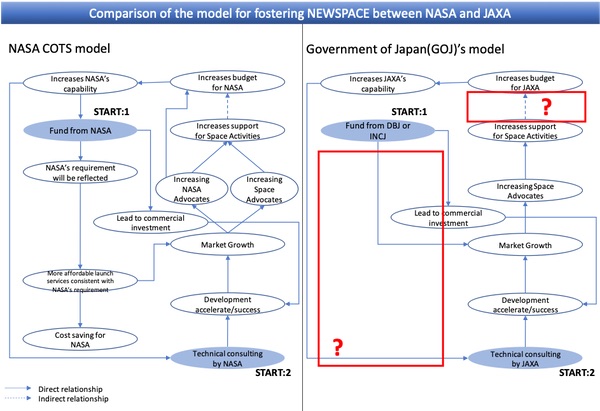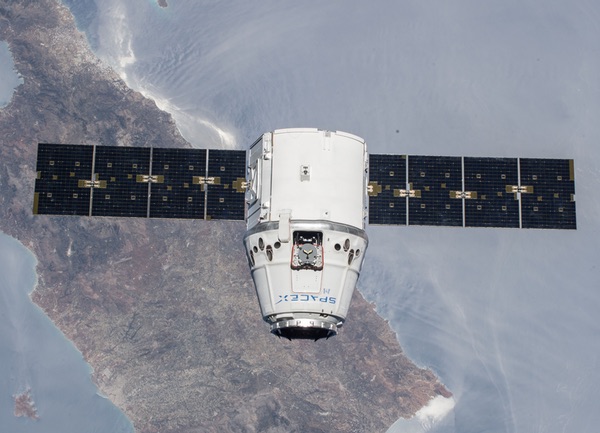How should Japan’s space agency foster NewSpace?by Takashi Uchino
|
| In Japan, the investor is not the space agency JAXA but rather public-private partnership funds. |
This article makes a comparison between US and Japanese initiatives, and extract takeaway for further consideration for supporting NewSpace in Japan.
A comparison of American and Japanese initiatives
Compared to NASA’s program model used in COTS (hereinafter “NASA model”), the main difference between the two countries is who is the investor. In Japan, the investor is not the space agency JAXA but rather public-private partnership funds, such as Development Bank of Japan (DBJ) and the Innovation Network Corporation of Japan (INCJ).
Can JAXA adopt the NASA model for fostering NewSpace? It can’t, for several reasons discussed below.
1. Agency’s scope of activities
In Japan, all governmental organizations have provisions regarding their scope of activities. If these definitions do not exist, such agencies could pursue activities that are not related to organization’s purpose, and it will result in wasting of their budgets.
Table 1 shows the scope of activities of NASA and JAXA can pursue based on national laws. According to its purpose set in JAXA’s establishment law, JAXA cannot spend money on research and development (R&D) conducted by private companies only for their benefit. Nevertheless, while JAXA contracts R&D or manufacturing to private companies, JAXA’s role is to conduct R&D by itself or within its responsibility. If the R&D was conducted by private companies only for their benefit, it will be beyond the scope of JAXA’s activities.
On the other hand, NASA has broader provisions in its organic act from 1958 that provides a basis to invest for private industries through COTS-like programs.
Table. 1 Comparison of scope of activities between NASA and JAXA
| National Aeronautics and Space Act of 1958 | LAW CONCERNING JAPAN AEROSPACE EXPLORATION AGENCY |
|---|---|
| FUNCTIONS OF THE ADMINISTRATION Sec. 203. (a) The Administration, in order to carry out the purpose of this Act, shall-- (1) plan, direct, and conduct aeronautical and space activities; (2) arrange for participation by the scientific community in planning scientific measurements and observations to be made through use of aeronautical and space vehicles, and conduct or arrange for the conduct of such measurements and observations; and (3) provide for the widest practicable and appropriate dissemination of information concerning its activities and the results thereof. |
Article 2. (Definitions) 3. The term “Satellites”, used in this Law, means satellites (including flying objects to be launched beyond Earth orbit and artificial objects to be placed on celestial bodies) and rockets for their launch. Article 18. (Scope of Activities) 1. In order to achieve the objectives referred to in Article 4, the Agency shall conduct the following activities: (1) Academic research relating to Space Science in collaboration with universities or otherwise; (2) Basic research relating to space science and technology, as well as aeronautical science and technology, and Fundamental Research and Development relating to space and aeronautics; (3) Development of Satellites and development of facilities and equipment necessary therefor; (4) Launch, tracking and operation of Satellites and development of methods, facilities and equipment necessary therefor; (5) Dissemination of results of the activities referred to in each of the preceding Items, and promotion of utilization thereof; (6) Assistance and advice, regarding Items (3) and (4), to private enterprises upon their request (7) Provision of its facilities and equipment for the use by entities conducting academic research, research and development relating to science and technology, and space development and utilization; (8) Training of researchers and engineers in Space Science, space science and technology, and aeronautical science and technology, and to enhance their capabilities; (9) Cooperation, upon request by individual universities, in education programs for graduate school and other education at the corresponding university; and (10) Activities incidental to those stipulated in each of the foregoing. |
2. Subsidy and investment
The features of COTS agreements are described in “COTS Model for NASA Public-Private Partnership” in NASA’s final report on the program. According to this report, the Space Act Agreement (SAA) based on Other Transaction Authority (OTA) is a significant feature, but the government of Japan does not have streamlined, flexible acquisition process like OTA. However, it seems to be possible for the Japanese government to establish COTS features in the current framework through modifying language in the contracts. In fact, programs containing features such as “pay for milestones” and “skin in the game” have been already executed by the Japanese government.
However, it is impossible for JAXA to fund a program on research and development conducted by private companies. There are some reasons.
First, when governmental organizations subsidize private companies without obtaining deliverables, a provision that includes the word “subsidize” is required in its scope of activities in the law. As shown in Table 1 above, JAXA has no provision to subsidize.
Second, there is another way, peculiar for Japan’s National Research and Development Agencies (NRDA), including JAXA, to invest to private companies. To enable an NRDA to invest, there is a law called the Research and Development Enhancement Act (officially called the “Act on Improving the Capacity, and the Efficient Promotion of Research and Development through Promotion of Research and Development System Reform.”) In this context, the word “invest” is different from subsidizing. Although the NASA model is one of subsidies, NRDA will obtain compensation, like stock, from the company instead of investment of money enabled by the law. But according to the law, investments are permitted only when the projects on R&D are originated from NRDA’s outcomes (Table 2). Thus, the law focuses on only the model for innovation through technology transfer from government to industries.
| It can be argued that COTS-like programs were realized because scale of space activities in US are big compared to Japan. |
In addition to this, only three agencies have authorities to invest: Japan Science and Technology Agency (JST), National Institute of Advanced Industrial Science and Technology (AIST), New Energy and Industrial Technology Development Organization (NEDO). Only JST has the authority to invest money and the others may only offer contributions of materials or equipment. Also, investments by NRDA are always under pressure not to damage its initial fund. These requirements are not suitable for investment on R&D of cutting-edge science and technology.
Table. 2 An Extract from the Research and Development Enhancement Act
|
(Contribution by Research and Development Agencies) Article 43-2: In order to promote the practical application of Research and Development results and Developing Innovation through the practical application, Research and Development Agencies that own Research and Development results deemed to require practical application and Developing Innovation through the practical application (as listed in Annex Table 2) may offer contributions, personnel, and technical aid as specified by the provisions of Article 1, paragraph (1) of the Act on General Rules for Incorporated Administrative Agencies and under relevant individual laws for a person who intends to utilize the Research and Development results achieved by the Research and Development corporation in a business activity. |
3. Scale of national space activities and budget
The recent example of Japanese launch vehicle development is the H3 rocket. The main rationales for deciding to proceed with H3 R&D were securing autonomy of governmental space activities, maintaining and increasing Japan’s capability to develop launch vehicles, and obtaining a strong competitive position in the market. Because Japan does not have large budget compared with US and Europe, GOJ had to realize all rationales in one project simultaneously. If JAXA would hand over the development of launch vehicle to industries, the space autonomy of the government might no longer be secured.
On the other hand, NASA continues R&D of launch vehicles like the Space Launch System during the COTS program. Also, the US Air Force supports development of launch vehicles such as through the EELV program. It can be said that programs conducted by multiple departments contribute to secure autonomy of space activities, and maintain and increase the US capability to develop launch vehicles. Under this situation, US private industries in the COTS program could seek to strengthen their competitiveness with the support of NASA. It can be argued that COTS-like programs were realized because scale of space activities in US are big compared to Japan.
Consideration
Figure 1 is a comparison between the NASA model and the current model used by the Japanese government, through a fishbone chart that identifies causal relations.
The chart shows that NASA can obtain direct benefit, including cost savings, through the cycle of the program. As it’s clear from the history of creating the COTS program, including the space exploration policy of the George W. Bush Administration, the NASA model can be said to contribute to both market growth and NASA’s benefit. On the other hand, in the Japanese government’s initiative, JAXA cannot acquire direct benefit but rather only indirect benefit from commercial market growth (described in the red boxed of Figure 1.)
 Fig.1 Fishbone chart of fostering New Space |
This analysis offers some suggestions for Japanese efforts:
1. Policy makers need to create a system in Japan that enables JAXA to grow through market vitality
The Japanese government model can be said to be cost effective because governmental spending is reduced by including private resources from investors. Although JAXA does not spend any money in the initiative, increasing space supporters might have the potential to contribute to an increase in JAXA’s budget. But this influence still remains indirect. JAXA has suffered from decreases in its budget for a decade, and it is difficult to recover that budget easily because of budget pressure from the entire science, technology, and innovation policy. In these circumstances, JAXA should not rely only on its budget from the Ministry of Education, Culture, Sports, Science and Technology (MEXT). It needs to create a system for agencies to mature through vitality of market growth.
2. The Ministry of Economy, Trade and Industry (METI) should prepare new funds for JAXA to foster NewSpace
| It is necessary for Japan to consider a new system that enables the creation of new markets through revised procurement models. |
If the word “subsidize” were included in the scope of activity for JAXA through a revision of the law, extra funds for subsidy would be needed. But as mentioned above, JAXA is suffering from declining budgets and so cannot afford to spend any money to support the growth of private companies. MEXT, the only provider of JAXA’s budget, has no authority to subsidize private companies in support of market growth. Because subsidizing private space companies for market growth is only in the scope of METI, that ministry should prepare extra funds for JAXA to foster NewSpace.
3. Japan should consider alternative procurement models to support space startups
The target of investment enabled by the Research and Development Enhancement Act is limited only to those startups that conduct practical application of S&T transferred from government. This law can promote technology transfer from government to startups. However, it is clear from the result of the NASA model that the perspective of governmental procurement is important not only for cost saving but also to create and foster new markets for cutting-edge S&T. It is necessary for Japan to consider a new system that enables the creation of new markets through revised procurement models, such as through the revision of the Research and Development Enhancement Act.
Note: we are temporarily moderating all comments subcommitted to deal with a surge in spam.
